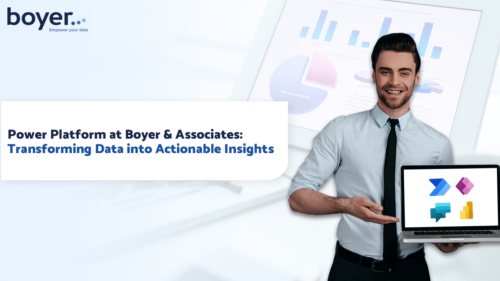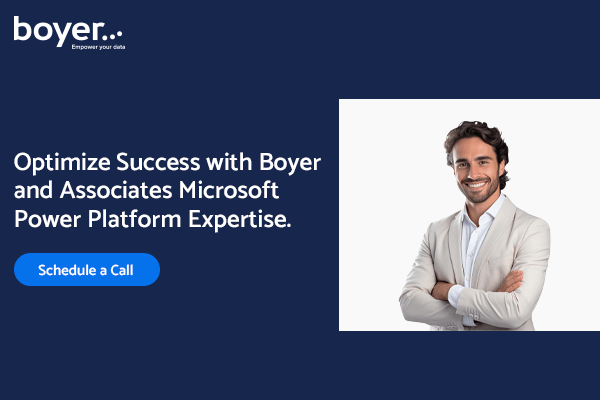Microsoft Power Platform is a cutting-edge toolset that empowers individuals and organizations to harness the power of data and turn it into actionable insights. Its suite of powerful components includes Power BI and Power Automate. The platform offers a versatile solution for data processing and workflow automation.
Designed for those who value flexibility and independence, Power Platform allows users to analyze data, create visually stunning reports, and automate repetitive tasks with ease. It enables businesses to make data-driven decisions, identify trends, and optimize processes, ultimately driving innovation and growth.
In this article, we will explore the key components of Microsoft Power Platform and delve into real-world applications that showcase its transformative capabilities.
Key Takeaways
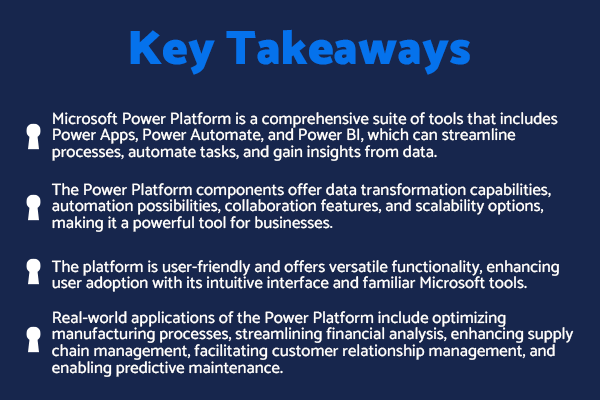
- Microsoft Power Platform is a comprehensive suite of tools that includes Power Apps, Power Automate, and Power BI, which can streamline processes, automate tasks, and gain insights from data.
- The Power Platform components offer data transformation capabilities, automation possibilities, collaboration features, and scalability options, making it a powerful tool for businesses.
- The platform is user-friendly and offers versatile functionality, enhancing user adoption with its intuitive interface and familiar Microsoft tools.
- Real-world applications of the Power Platform include optimizing manufacturing processes, streamlining financial analysis, enhancing supply chain management, facilitating customer relationship management, and enabling predictive maintenance.
Understanding Microsoft Power Platform
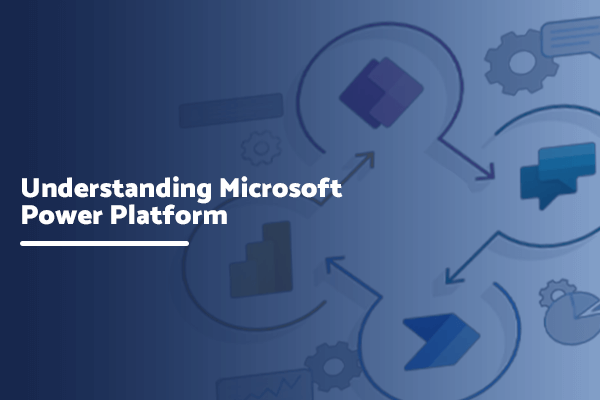
To understand Microsoft Power Platform, it is essential to familiarize oneself with its components, benefits, and usability.
The platform includes Power Apps, Power Automate, and Power BI, each serving a specific purpose in transforming data into actionable insights.
By leveraging these components, organizations can streamline processes, automate tasks, and gain valuable insights from their data.
Real-world applications of Microsoft Power Platform include building custom applications, automating workflows, and creating interactive visualizations for data analysis and reporting.
Power Platform Components
The Power Platform’s components provide organizations with a comprehensive suite of tools to harness and leverage their data for actionable insights. With its power platform integration, organizations can seamlessly connect and integrate data from various sources, enabling a holistic view of their operations.
The platform’s data transformation capabilities allow organizations to cleanse, shape, and analyze data, ensuring its accuracy and relevance. Moreover, the automation possibilities offered by the Power Platform enable organizations to streamline and optimize their business processes. This increases efficiency and productivity.
Collaboration features such as real-time data sharing and collaborative workspaces facilitate teamwork and knowledge sharing. Lastly, the Power Platform’s scalability options ensure that organizations can adapt and grow, accommodating increasing data volumes and user demands.
With these components, organizations have the freedom to transform their data into actionable insights, empowering them to make informed decisions and drive success.
Benefits and Usability
With its user-friendly interface and versatile functionality, Microsoft Power Platform offers organizations numerous benefits and a high level of usability. The platform allows users to easily analyze and visualize data, create custom applications, and automate business processes.
One of the key benefits of Power Platform is its ability to enhance user adoption. The intuitive interface and familiar Microsoft tools make it easier for employees to learn and use the platform.
However, there are also some limitations to consider. Integration challenges may arise when trying to connect Power Platform with other systems or data sources. Data security is another important aspect to consider, as organizations need to ensure that sensitive information is protected.
To overcome these challenges, adequate training and support should be provided to users to maximize the platform’s potential.
At Boyer & Associates, we can help you optimize Power Platform to get the most out of your investment. We are a trusted Microsoft partner with extensive knowledge and experience with Microsoft Power Platform.
Real-world Applications
Real-world organizations are leveraging the capabilities of Microsoft Power Platform to unlock the potential of their data and turn it into actionable insights.
With the platform’s robust features, organizations can optimize manufacturing processes by analyzing production data, identifying bottlenecks, and implementing efficiency improvements.
Financial analysis becomes streamlined and more accurate as Power Platform allows for the seamless integration of financial data from various sources. This enables organizations to make informed decisions based on real-time information.
Supply chain management is enhanced through the platform’s ability to track inventory, monitor delivery schedules, and optimize logistics.
Customer relationship management is made easier with Power Platform’s comprehensive tools for data management, customer engagement, and sales automation.
Lastly, organizations can achieve predictive maintenance by analyzing equipment data to detect potential failures and schedule maintenance proactively, reducing downtime and costs.
Plunkett’s Pest Control uses Power Apps to track and organize its fleet of trucks. Boyer helped them set up Power Platform, optimizing organization and saving valuable time.
Microsoft Power Platform truly empowers organizations to leverage their data and drive meaningful business outcomes.
Power Platform’s Key Components
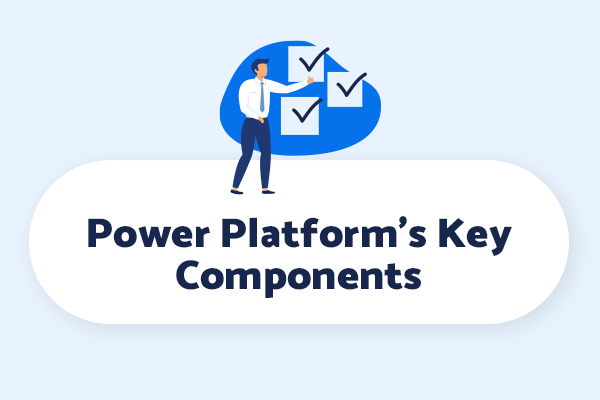
To understand the key components of Microsoft Power Platform, it is important to explore three main areas: Power Apps, Power Automate, and Power BI.
Power Apps enables users to create custom applications without the need for coding.
Power Automate allows for the automation of repetitive tasks across various applications.
Power BI provides essential tools for data visualization and analysis, enabling organizations to transform data into actionable insights.
Understanding Power Apps
Power Apps is an essential component of the Microsoft Power Platform, enabling users to create, customize, and deploy business applications with ease.
With Power App development, users have the freedom to design and build applications tailored to their specific needs. The platform offers extensive app customization options, allowing users to create a unique user experience design that aligns with their brand and enhances user engagement.
Power Apps also facilitates seamless data integration, enabling users to connect their applications with various data sources, both on-premises and in the cloud. Once the app is developed and customized, it can easily be deployed across multiple devices and platforms, providing users with the freedom to access and utilize their applications whenever and wherever they need.
Power Automate Usage
One of the key components of the Microsoft Power Platform is Power Automate. It allows users to streamline and automate their business processes. With Power Automate, users can automate approvals, enabling them to quickly move through various stages of the approval process. This process automation helps save time and improves overall productivity.
Additionally, Power Automate enables data integration. Users can connect and automate tasks across different systems and applications. This seamless integration enhances task management and enables users to efficiently track and manage their workflows.
Power BI Essentials
A key component of the Microsoft Power Platform is Power BI Essentials, which provides users with essential tools for transforming data into actionable insights.
Power BI is a powerful business intelligence tool that allows users to create interactive dashboards and reports, enabling them to visualize and analyze data in a meaningful way.
With Power BI training and certification, users can become proficient in using this tool and leverage its capabilities to make informed decisions. Power BI dashboards and reports offer a comprehensive view of data, allowing users to gain insights and identify trends.
Additionally, there are various Power BI tutorials available to help users learn and master the tool’s features and functionalities.
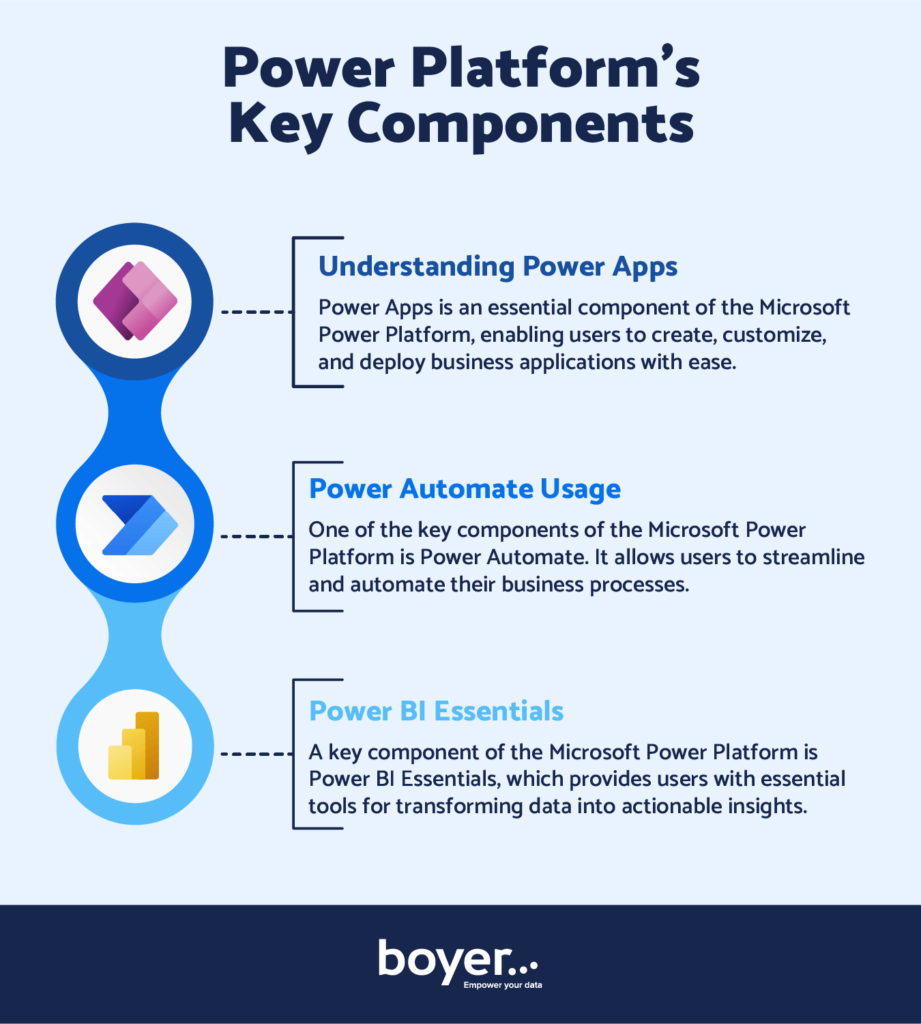
Data Processing With Power BI
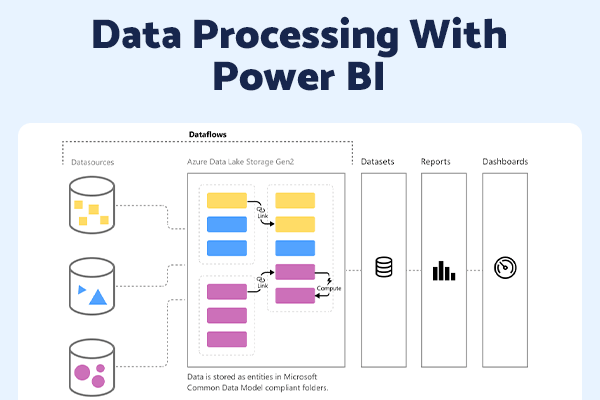
Data processing with Power BI involves utilizing its powerful features, such as data visualization, advanced analytics, and custom data modeling.
Power BI enables users to transform raw data into meaningful insights through its intuitive visualizations and interactive dashboards.
With its advanced analytics capabilities, users can perform complex data analysis, uncover patterns, and make data-driven decisions.
Additionally, Power BI allows for custom data modeling, enabling users to structure and organize data according to their specific needs and requirements.
Power BI Data Visualization
The efficient processing of data with Power BI enables organizations to transform their raw information into visually compelling and actionable insights. Power BI’s data visualization capabilities allow for effective data analysis and exploration, empowering users to make data-driven decisions.
With interactive dashboards, users can easily navigate and interact with their data, gaining a deeper understanding of patterns and trends. Power BI also supports data storytelling, allowing users to create engaging narratives using their data.
Advanced Analytics Features
Power BI’s advanced analytics features enhance data processing capabilities, enabling organizations to extract valuable insights and drive informed decision-making.
With its advanced analytics capabilities, Power BI empowers users to perform predictive modeling, machine learning, data mining, and anomaly detection on their data.
These features allow organizations to go beyond basic data visualization and delve deeper into their data to uncover hidden patterns, trends, and correlations. Predictive modeling enables organizations to make data-driven forecasts and predictions. At the same time, machine learning algorithms can automatically learn from data and make intelligent predictions or recommendations.
Data mining helps identify patterns and relationships in large datasets, and anomaly detection flags unusual or abnormal data points for further investigation.
Custom Data Modeling
Custom data modeling in Power BI is a powerful tool that allows organizations to tailor their data processing to their specific needs. With data modeling, organizations can analyze and transform their data to gain valuable insights and make data-driven decisions.
Power BI provides a range of features and capabilities for data modeling, including data transformation, data analysis, and data visualization. These features enable organizations to manipulate and shape their data to suit their unique requirements.
By customizing the data modeling process, organizations can ensure that they are extracting the most relevant and meaningful information from their data. In turn, this facilitates informed decision-making.
With Power BI’s custom data modeling capabilities, organizations have the freedom to optimize their data processing workflows and achieve actionable insights.
Automating Workflows With Power Automate
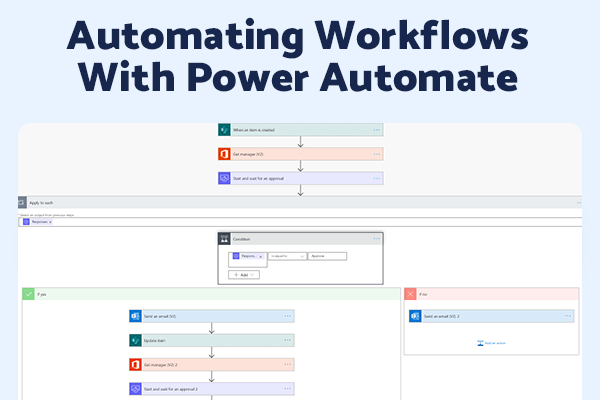
Power Automate, a component of the Microsoft Power Platform, offers several benefits to organizations looking to automate their workflows. By implementing automated processes, businesses can streamline their operations, increase efficiency, and reduce manual errors.
However, some challenges come with integrating Power Automate, such as ensuring compatibility with existing systems and addressing security concerns.
Power Automate Benefits
With the integration of Microsoft Power Automate, organizations can streamline their workflows and increase efficiency by automating tasks and processes. Power Automate offers numerous benefits that contribute to workflow automation, process optimization, time-saving benefits, and increased productivity.
By automating repetitive and manual tasks, employees are freed up to focus on more strategic and value-added activities. This not only saves time but also reduces the risk of errors and improves overall accuracy.
Power Automate also enables organizations to connect and integrate different systems and applications, facilitating seamless data flow and information sharing. This eliminates the need for manual data entry and ensures real-time access to up-to-date information.
Additionally, Power Automate provides a wide range of pre-built connectors and templates, allowing organizations to quickly and easily automate common business processes. This eliminates the need for extensive coding or development skills.
By using managed services for software management, you can reap the benefits of Power Automate. Boyer has the experience to improve your company’s efficiency with automation.
Implementing Automated Processes
Implementing automated processes is crucial for organizations looking to maximize efficiency, streamline workflows, and optimize their operations.
With the help of Power Automate, organizations can automate repetitive tasks and create efficient workflows.
One key aspect of implementing automated processes is automated reporting. By integrating data from various sources, organizations can generate real-time reports, eliminating the need for manual data collection and analysis.
Workflow automation plays a vital role in reducing manual intervention and ensuring smooth and seamless processes. It enables organizations to automate the movement of data between different systems, improving data integration and reducing errors.
Process optimization is another key benefit of implementing automated processes. By automating tasks, organizations can eliminate bottlenecks, reduce turnaround time, and improve overall efficiency.
Task automation allows employees to focus on more strategic and value-added activities, ultimately boosting productivity and driving business growth.
Power Automate Challenges
One of the challenges in automating workflows with Power Automate is ensuring seamless integration of data between systems. Organizations often struggle with automating emails, process optimization, and overcoming integration challenges to achieve workflow efficiency.
Power Automate offers a range of connectors to facilitate data exchange, but configuring these integrations can be complex. Businesses need to carefully analyze their existing systems and identify potential bottlenecks or gaps in the automation process.
Additionally, ensuring that the automated workflows align with the organization’s objectives and desired outcomes is crucial. Business automation using Power Automate requires a strategic approach, considering the unique needs and requirements of the organization.
Overcoming these challenges will pave the way for streamlined processes and improved productivity.
Real-World Applications of Microsoft Power Platform

The real-world applications of Microsoft Power Platform are diverse and impactful.
In the healthcare sector, organizations are utilizing the platform to streamline patient data management, improve communication, and enhance operational efficiency.
The retail industry is leveraging Power Platform to optimize inventory management, analyze customer data, and automate sales processes.
Additionally, non-profit organizations are implementing Power Platform to streamline fundraising efforts, track donations, and enhance collaboration among team members.
Healthcare Sector Use
Numerous healthcare organizations have successfully adopted Microsoft Power Platform to leverage its data-driven capabilities and improve operational efficiency.
The platform’s robust data management tools allow healthcare providers to collect, analyze, and securely store patient data, enabling them to make informed decisions and provide better patient care.
With Power Platform’s predictive analytics capabilities, healthcare organizations can identify trends and patterns in patient data, leading to more accurate diagnoses and personalized treatment plans.
Additionally, the platform’s user-friendly interface and intuitive features enable healthcare professionals to streamline administrative tasks, saving time and improving operational efficiency.
Data security is also a top priority, as Power Platform ensures that sensitive patient information is protected through advanced encryption and access controls. Boyer can activate all the data security capabilities in Power Platform so that you can use the platform’s features to your greatest advantage.
Retail Industry Applications
Microsoft Power Platform is actively utilized in the retail industry to harness its data-driven capabilities and drive actionable insights for improved operational efficiency and customer experience. Within the competitive retail industry, businesses are leveraging the power of the platform to enhance customer engagement, optimize their supply chain, streamline inventory management, and leverage predictive analytics.
By integrating various data sources, such as point-of-sale systems, customer relationship management software, and e-commerce platforms, Microsoft Power Platform enables retailers to gain a holistic view of their operations. This comprehensive insight allows them to identify trends, anticipate customer needs, and make data-driven decisions to improve their overall performance.
Retailers can use the platform’s predictive analytics capabilities to forecast demand, optimize pricing strategies, and effectively manage inventory levels. This helps to reduce costs, minimize stockouts, and maximize sales opportunities. Additionally, the platform’s customer engagement tools enable retailers to personalize their marketing efforts, enhance customer loyalty, and deliver a seamless shopping experience across multiple channels.
Nonprofit Organization Implementation
Nonprofit organizations are leveraging the data-driven capabilities of Microsoft Power Platform to implement real-world applications and drive positive social impact. With the platform’s robust features, nonprofits can effectively manage their nonprofit funding, volunteer management, impact measurement, donor engagement, and program evaluation.
Microsoft Power Platform enables nonprofits to streamline their operations and make informed decisions based on data analytics. By utilizing the platform’s powerful tools, nonprofits can track and manage their funding sources, ensuring transparency and accountability.
Volunteer management becomes more efficient, enabling organizations to match volunteers with the right opportunities and track their impact. Impact measurement and program evaluation become easier, allowing nonprofits to understand the effectiveness of their programs and make necessary adjustments.
Moreover, donor engagement is enhanced, enabling nonprofits to build strong relationships with their supporters and increase fundraising efforts. Through Microsoft Power Platform, nonprofits can harness the power of data to drive meaningful change and create a better world.
Boyer & Associates works with nonprofits to help optimize operations unique to their needs. Whether the organization has an upcoming annual fundraising event or needs a way to track every dollar donated, Boyer can get you started with Power Platform so that you can focus on more important things.
Frequently Asked Questions

Can Power Platform be integrated with other data sources outside of Microsoft applications?
Yes, Power Platform offers third-party integration opportunities, allowing for data consolidation and enhancing data analytics. It enables expanding data sources and leveraging external data insights, providing freedom to incorporate diverse data into actionable insights.
Is It possible to schedule automated workflows at specific times and intervals?
Yes. This feature offers several benefits in improving productivity, and there are best practices to follow for scheduling, optimizing performance, and troubleshooting issues.
What are the security measures in place to protect data processed through Power Platform?
Data protection and security measures are essential when it comes to data processing. Privacy concerns and data security are of utmost importance. Robust security measures are in place to ensure the protection of data processed through the Power Platform.
Increase Efficiency and Automation with Microsoft Power Platform
In conclusion, Microsoft Power Platform is a powerful tool for transforming data into actionable insights. Its key components enable efficient data processing and workflow automation.
By harnessing the capabilities of Power Platform, organizations can make informed decisions and streamline their operations. With real-world applications across various industries, Power Platform has proven to be a valuable asset in driving data-driven decision-making and improving overall efficiency.
At Boyer & Associates, we don’t just see the Power Platform as an add-on; we recognize it as a cornerstone for transformative business solutions. Embrace a smarter approach to business efficiency without the need for overwhelming system overhauls.
Ready to start small and achieve big with Boyer’s expert guidance? Contact us today and take the first step towards streamlined success with the Power Platform. Whether you are a nonprofit or commercial business, we have you covered.


